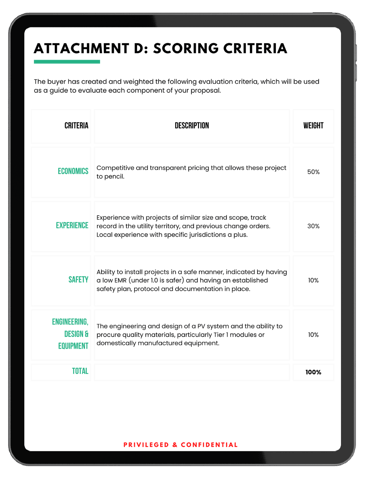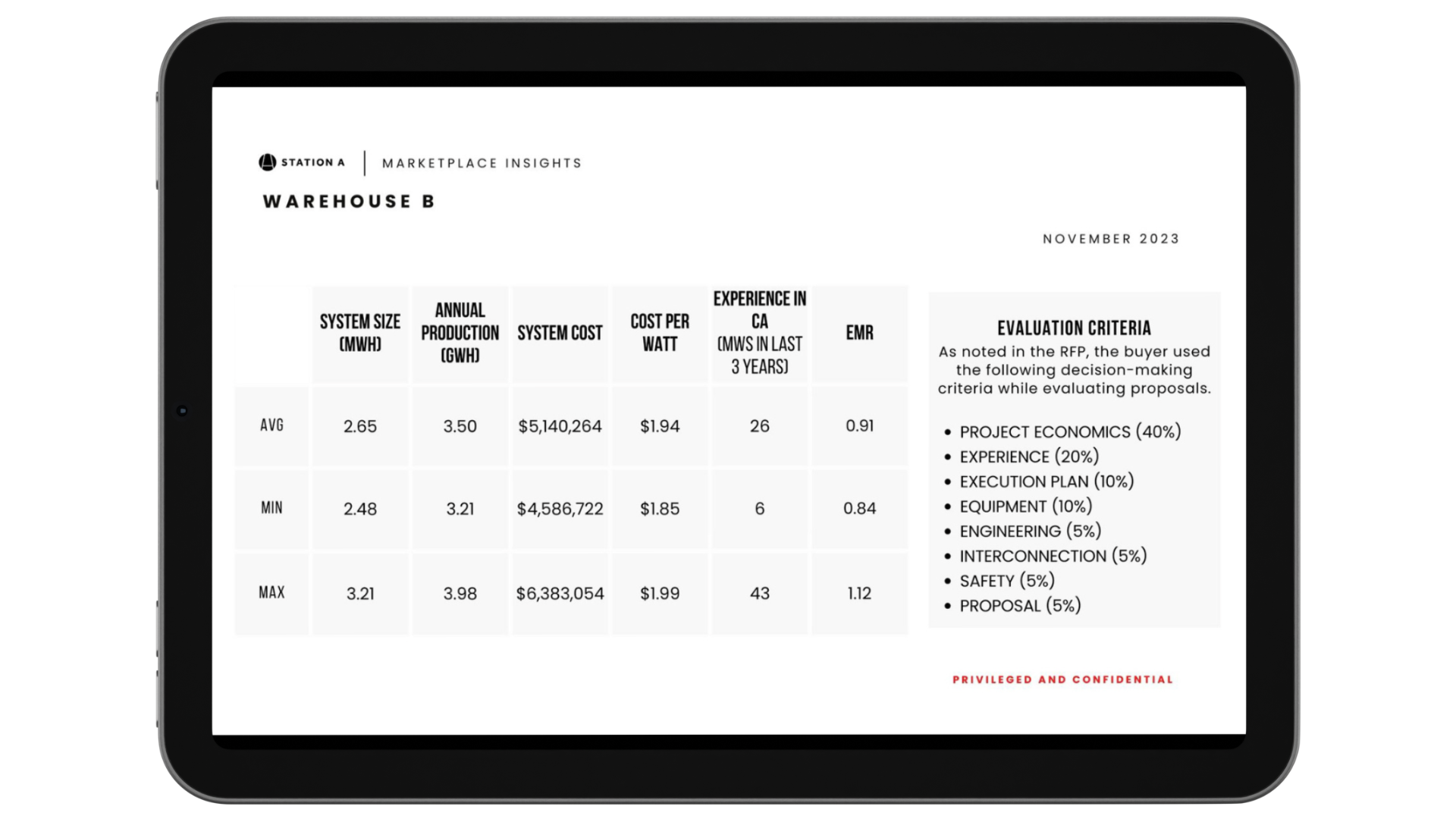Submitting a proposal through Station A is a faster and more organized way to participate in RFPs (Request for Proposals) and RFQs (Request for Qualifications) in the clean energy space. Whether you’ve submitted proposals for Station A before or are considering it for the first time, this guide provides transparency into the way Station A evaluates proposals.
🧐 How are proposals submitted?
Proposals are started and submitted in Station A’s Platform. The typical Q&A period lasts 2 weeks, followed by a 2-week proposal submission period. Each proposal contains base questions plus additional questions specific to the project or the buyer's needs.
Disclosures
Before submitting a proposal, providers review the Disclosures package, which contains detailed data about the project’s scope and onsite characteristics, from utility bills to electrical equipment ratings. Station A collects significant data upfront and shares this with providers to minimize any surprises down the road and ensure that there is an even playing field for all respondents.
Proposal questions
Providers sometimes find that answers to numeric and multiple-choice questions require additional context. These notes can be highlighted in the ‘Notes’ section under each answer. This way, if a provider isn't able to give a numeric answer for any reason, or if their numeric response has a caveat, they can explain so in the notes.
%20(1).png?width=1920&height=1080&name=Product%20Mocks%20(9)%20(1).png)
If your company has submitted a Station A proposal before, you may have received a follow-up email from a Marketplace Success Rep after the due date that notes a potential error in your response or requests clarification. Rather than disqualifying a proposal for missing or incorrect information, Station A spends extra time rectifying this data to ensure that providers are correctly represented.
🧮 How are proposals scored?
As part of the RFP’s disclosures package, buyers provide weighted scoring criteria indicating their key project focuses. See an example below.

Once the submission period closes, Station A performs a deep-dive analysis of each proposal. Our team reviews all responses, ‘Note’ sections, and attachments that are submitted. Station A reviews all caveats, assumptions, and context to give the buyer a holistic view of your proposal.
After the entirety of the proposal is reviewed, Station A scores proposals according to the weighted criteria shared in the project disclosures, and delivers the buyer a presentation that includes your original responses.
Types of scoring
Let's take the 'Experience' criteria as an example. To score a proposal for Experience, Station A considers numeric values like the number of MWs installed in the state or utility in the last 3 years. Providers will score higher in Experience for less black-and-white values as well: Context on known interconnection wait times or difficulties working with a given utility show boots-on-the-ground knowledge in the Experience category. Similarly, Experience would be scored higher if they show awareness of local incentives or system size caps, either from previous projects or by calling the utility. As another example, Safety is scored using hard numbers like EMR (Experience Modification Rating), but also softer factors like the presence of detailed safety and quality documentation.
Raw responses
When Station A presents proposal scores to the buyer, we give them an opportunity to dig into the data live and discuss points of confusion, excitement, or doubt. In addition to this conversation, buyers receive your full proposals, exactly as they were submitted through Station A. Because the buyer selects a shortlist and winner, not Station A, it's important that the buyer understands the positives and drawbacks of each proposal.
🥇 How is a shortlist selected?
After Station A and the buyer discuss each proposal, the buyer reviews submissions internally and chooses a shortlist based on their needs. At this point, a buyer may include a larger decision-making group that selects a shortlist together. Station A does not select a shortlist of providers on behalf of a buyer.
🏆 How is a winner selected?
Similarly, Station A does not select a winner on behalf of a buyer. Instead, our role is to explain how each provider compares to one another for the buyer’s own consideration. Since the buyer will ultimately work with the winning provider, it's critical that the buyer makes this decision on their own. The raw proposal data, summary analyses, scoring, and any shortlist responses or interviews all factor into a buyer's decision to select a winner. Oftentimes, multiple stakeholders are in charge of selecting and approving the ultimate winner. At this stage, Station A's main value is to answer questions, help a buyer calibrate pros and cons, and educate newer stakeholders on clean energy projects, enabling the entire buying group to feel confident in the winner.
🐎 Is it a race to the bottom?
Station A claims that its marketplace process is not a ‘race to the bottom’ like most RFPs. How does Station A ensure that this is the case?
To start, it’s important to recognize that price is a critical component of any clean energy project for commercial buyers. Each clean energy project needs buy-in from a finance team. However, it’s just one component of a proposal and any buyer’s overall decision around who to advance. Given the manner in which bids are evaluated holistically, the lowest cost per watt submitted does not win the majority of RFPs in the Station A Marketplace. To de-risk projects and protect their companies from poor experiences and change orders, buyers highly value criteria like experience, equipment, safety, and attention to detail. Buyers select providers that are likely to deliver good financial value and a positive experience so that clean energy projects are viewed as smooth and successful to other internal stakeholders. Buyers use Station A to select a high-quality provider that meets their decision-making criteria, thereby enabling more clean energy to be built.
📼 What do you offer providers post-project?
Providers spend significant time and resources assembling thoughtful proposals for these projects. The average Station A RFP receives 6 bids, some of which have stiff competition. Especially for providers who submit to many RFPs or RFQs without being selected, participating in this process is frustrating and can lead to fatigue. To recognize providers' efforts and help them win business next time, Station A offers two post-project benefits:
Debrief calls
Once providers are notified that they did not win a project, they are sent a link to schedule a debrief call with their Marketplace Success Rep. During these calls, we review the proposal and discuss the highs and lows as noted by the buyer.

Marketplace Insights
After the RFP finishes, providers also receive a 'Marketplace Insights' sheet which shows anonymized metrics from the RFP, including cost per watt, total cost, system size, and experience metrics. These insights provide a real-time view into the market for providers to use in other upcoming proposals.
👍 In summary
In summary, the goal of Station A's marketplace is to allow providers to navigate the competitive clean energy landscape in a way that feels more transparent, simple, and useful than the traditional RFP process. We regularly act on feedback submitted by our provider network and hope you decide to provide thoughts via the “How did we do?” email that is sent each time you submit a proposal. We encourage you to submit proposals for upcoming projects by visiting the Station A Marketplace.